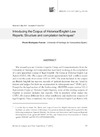Identificador persistente para citar o vincular este elemento:
https://accedacris.ulpgc.es/jspui/handle/10553/9723
| Título: | Introducing the Corpus of Historical English Law Reports: Structure and compilation techniques | Autores/as: | Rodríguez-Puente, Paula | Clasificación UNESCO: | 570107 Lengua y literatura 550510 Filología |
Palabras clave: | Law reports Legal english Diachronic corpus Corpus compilation |
Fecha de publicación: | 2011 | Publicación seriada: | LFE. Revista de Lenguas para Fines Específicos | Resumen: | The research group Variation, Linguistic Change and Grammaticalization from the University of Santiago de Compostela has been lately working on the compilation of a new specialised corpus of legal English: The Corpus of Historical English Law Reports (CHELAR). The corpus will contain approximately half a million words and cover the years from about 1535 to 1999. The texts included in the corpus are British English law reports: records of judicial decisions that are “cited by lawyers and judges for their use as precedent in subsequent cases” (EBO, n.d.). Except for the legal section of the forthcoming ARCHER corpus version 3.2 (A Representative Corpus of Historical English Registers), none of the existing corpora of English at present includes law reports. This is precisely what makes the CHELAR corpus different from other synchronic and diachronic corpora of legal English. Once completed, the Corpus of Historical English Law Reports will, therefore, constitute a new, useful resource for linguists with an interest in legal language, from both a synchronic and a diachronic perspective. | URI: | https://accedacris.ulpgc.es/handle/10553/9723 | ISSN: | 1133-1127 | Fuente: | LFE. Revista de lenguas para fines específicos. Las Palmas de Gran Canaria: Universidad de Las Palmas de Gran Canaria, 1993 [ISSN 1133-1127], n. 17, 2011, p. 99-120 |
| Colección: | LFE, Rev. leng. fines específ. n.17, 2011 Artículos |
Visitas
125
actualizado el 21-dic-2024
Descargas
222
actualizado el 21-dic-2024
Google ScholarTM
Verifica
Comparte
Exporta metadatos
Los elementos en ULPGC accedaCRIS están protegidos por derechos de autor con todos los derechos reservados, a menos que se indique lo contrario.
